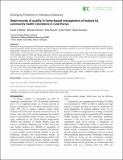| dc.contributor.author | O Marita, Enock | |
| dc.contributor.author | Gichuki, Richard | |
| dc.contributor.author | Watulo, Elda | |
| dc.contributor.author | Thiam, Sylla | |
| dc.contributor.author | Karanja, Sarah | |
| dc.date.accessioned | 2021-11-17T20:38:05Z | |
| dc.date.available | 2021-11-17T20:38:05Z | |
| dc.date.issued | 2020-12-16 | |
| dc.identifier.citation | Marita, E. O., Gichuki, R., Watulo, E., Thiam, S., & Karanja, S. (2021). Determinants of quality in home-based management of malaria by community health volunteers in rural Kenya. Journal of infection in developing countries, 15(7), 897–903. https://doi.org/10.3855/jidc.13565 | en_US |
| dc.identifier.uri | https://repository.amref.ac.ke/handle/123456789/384 | |
| dc.description | Copyright © 2021 Marita et al. This is an open-access article distributed under the Creative Commons Attribution License, which permits unrestricted use, distribution, and reproduction in any medium, provided the original work is properly cited. | en_US |
| dc.description.abstract | Abstract
Introduction: Kenya adopted the World Health Organization’s recommendation of community case management of malaria (CCMM) in 2012. Trained community health volunteers (CHVs) provide CCMM but information on quality of services is limited. This study aimed to establish determinants of quality of service of CCMM conducted by CHVs.
Methodology: A cross-sectional survey was conducted in November 2016 in Bungoma County, Kenya. Data were collected through observing CHVs perform routine CCMM and through interviews of CHVs using structured questionnaires. A ≥ 75% score was considered as quality provision. Descriptive statistics were performed to describe basic characteristics of the study, followed by Chi-Square test and binary logistic regression to examine the differences and associations between the categorical variables.
Results: A total of 147 CHVs participated; 62% of CHVs offered quality services. There was a direct association between quality of services and stock-outs of artemether-lumefantrine (AL), stock-outs of malaria rapid diagnostic tests (RDT) and support supervision. CHVs who were supervised during the year preceding the assessment were four times more likely to perform better than those not supervised (uOR 4.2, 95% CI: 1.38-12.85). CHVs with reliable supplies of AL and RDT kits performed three times better than those who experienced stock outs (uOR = 3.2, 95% CI: 1.03-10.03 and 3.3, 95% CI: 1.63-6.59 respectively). Biosafety and documentation were the most poorly performed.
Conclusions: The majority of CHVs offered quality CCMM services despite safety gaps. Safety, continuous supplies of RDT, AL and supervision are essential for quality performance by CHV in delivering CCMM | en_US |
| dc.description.sponsorship | County Government of Bungoma, Kenya, | en_US |
| dc.language.iso | en | en_US |
| dc.publisher | The Journal of Infection in Developing Countries | en_US |
| dc.relation.ispartofseries | Emerging Problems in Infectious Diseases;J Infect Dev Ctries 2021; 15(7):897-903. doi:10.3855/jidc.13565 | |
| dc.subject | Quality service | en_US |
| dc.subject | Community health volunteers | en_US |
| dc.subject | Community case management of malaria | en_US |
| dc.title | Determinants of Quality In-home-based Management of Malaria by Community Health Volunteers in Rural Kenya | en_US |
| dc.type | Article, Journal | en_US |

